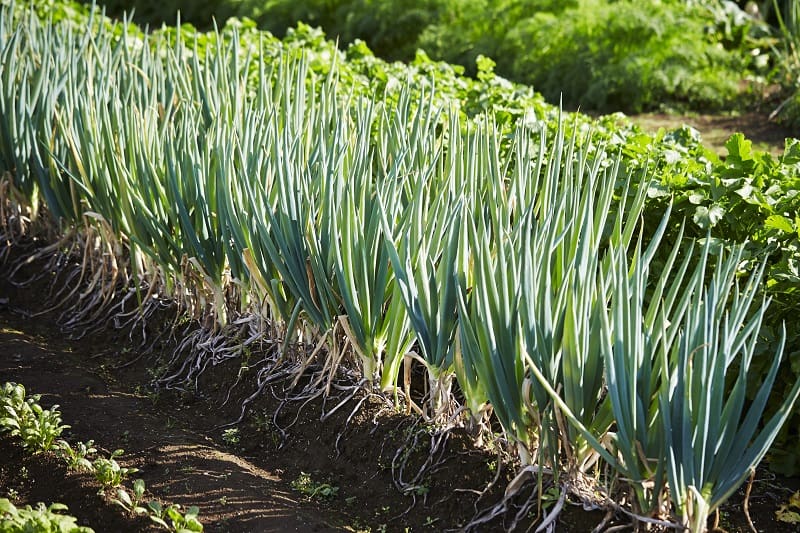
Green onions are also called scallions or spring onions. They are a vegetable species of the genus Allium. These plants have a milder taste than regular onions, and their close relatives are shallots, chives, leeks, Chinese onions and garlic. Their leaves are used raw or cooked, and they are available year-round. Like most plants, they are also prone to disorders that may cause them to yellow.
Common causes for green onions turning yellow
Overwatering or underwatering
Green onion plants thrive in soil that has consistent moisture, which means they should be properly and regularly watered. If you notice the leaves turning yellow, it could mean that you are over- or underwatering them. To figure out whether a watering issue is the culprit, push your finger into the soil up to the second knuckle. If you feel that the soil is too soggy or too dry, the cause of the yellowing leaves is probably poor watering techniques.
What to do:
Water the green onions with at least one inch of water weekly. See to it that the plants are evenly watered to prevent sogginess on any one particular part. You may also apply a layer of mulch to even out the soil’s moisture. Ideally, you should have a meter reader to determine whether you are watering the plants correctly.
Pests
Green onions may also turn yellow due to the presence of pests.
Common pests that could cause yellow leaves in green onions include:
- Onion maggots
These are common onion pests and, if not controlled, they could cause great damage to your crop. The larvae feed on the roots and bulbs and may also burrow into the shoots and leaves.
To eradicate these pests, use natural biological predators to reduce chemical residue in your plants. Predaceous ground beetles and Steinernema feltiae parasitic nematodes can significantly eradicate pests like onion maggots. Rotate the crops in your garden bed after harvesting the green onions and wait for the temperature to reach at least 95 degrees Fahrenheit before sowing the plants.
- Harmful nematodes
These nematodes are damaging to green onions and cause yellowing and wilting leaves. They live in the soil and could also result in stunted or deformed growth.
Check your crop history: you may have planted leeks, chives or lettuce that can be carriers of harmful nematodes. After an infestation, refrain from planting those crops for at least three years. Sanitize garden equipment to stop the spread of pests and clean materials thoroughly that have direct contact with the soil.
Diseases
Yellowing of green onions could also be due to fungal diseases, such as the following:
- Pink root
This soil-borne fungal disease, which also affects garlic, targets the roots of plants. Roots and bulbs become discolored, and it may also affect the color of the leaves. The tips of leaves may appear wilted and roots may turn pink, red or purple. The disease will eventually result in stunted growth and low yields.
What to do:
Rotate the crops to reduce the occurrence of the disease. This will also prevent the spread of the disease to other plants. Opt for disease-resistant green onion varieties to ensure healthy onions and a fuss-free harvest. Fumigation is also very useful to manage a fungal outbreak in your garden.
- Downy mildew
This fungal disease usually starts as harmless yellow spots on the leaves. However, once the yellowing begins, it becomes difficult to stop the spread of the disease. Leaves may start to dampen and bend, and the bulbs, stalks and flowers become watery.
What to do:
Avoid sprinkler irrigation and do not water from above the plants. Ensure that there is no moisture or water on the leaves and upper plant parts, and that the soil is well-draining. Apply the three-year rotation rule to reduce the number of fungi in the soil. Make sure that your bulbs and seeds are from healthy, mature plants, which means the mother plant does not have diseases.
- Bulb rot
This fungal disease is characterized by rotting bulbs and yellowing, wilting leaves. The bulbs darken and become watery, and eventually decay. The plants also tend to have stunted growth.
What to do:
Remove and dispose of the infected plants to avoid the spread of the disease.
Conclusion
Green onions, also known as scallions or spring onions, may suffer from discoloration due to various causes. Green onions turning yellow may be due to inefficient watering techniques, fungal diseases, or pests such as onion maggots.
Image: istockphoto.com / ma-no